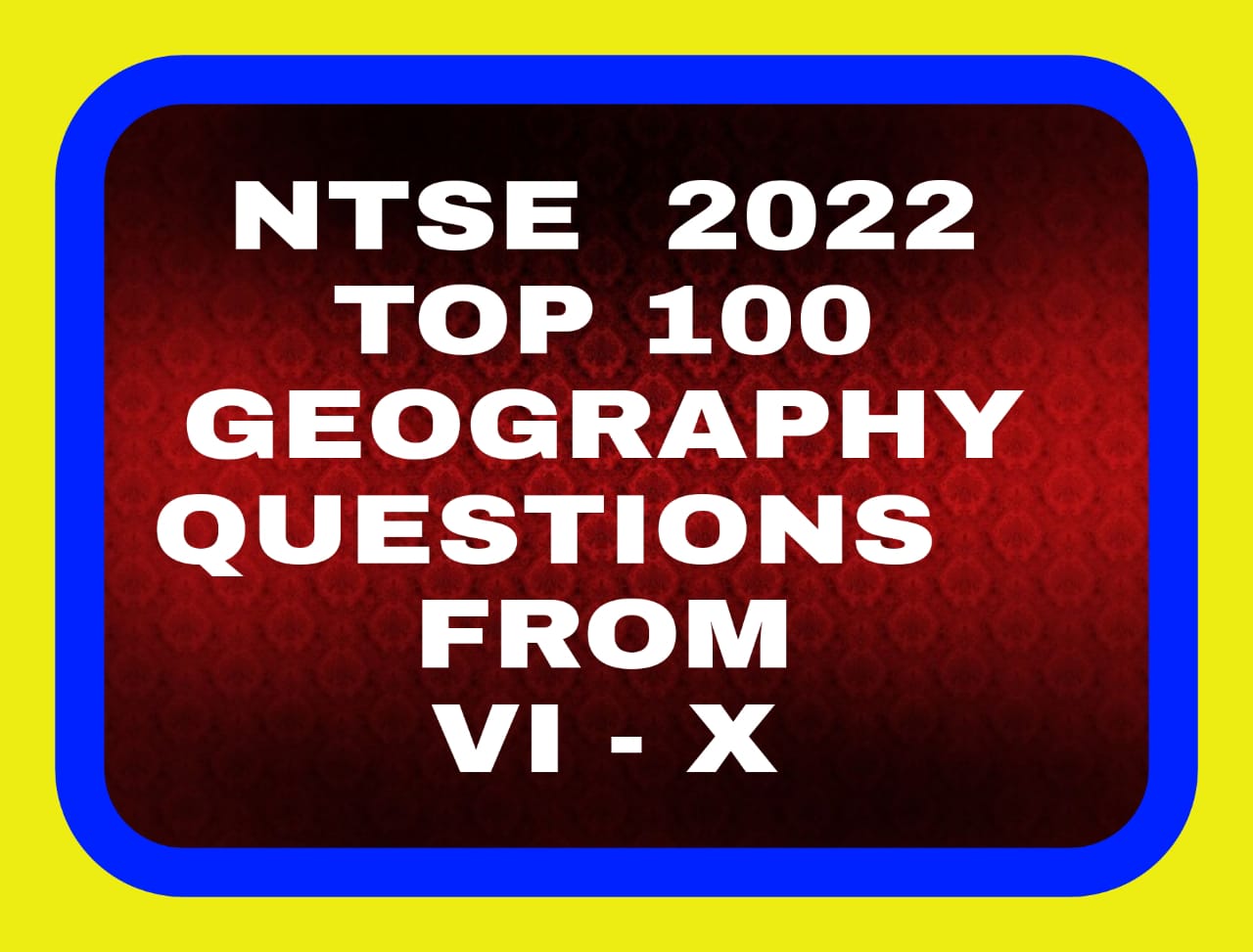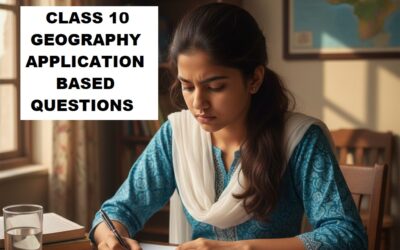NTSE 2022 Geography Questions For Class X Students – Part I
NTSE – 2022, popularly known as National Talent Search Examination is a prestigious National-Level exam. It is conducted by NCERT (National Council of Educational Research and Training) for class X students. It is conducted once in a year in two different stages. NTSE- 2022 Stage I exam will be a state level exam and will be conducted by all the states and Union Territories of India. The students who will clear stage I exam will qualify for stage II.
Stage-II will be a National level Exam. The students who will clear both the Stages will be eligible to receive the Scholarship. The scholarship will be given on the basis of the overall performance of students in Stage-I and Stage-II. The application form for this exam will be filled in online mode whereas the NTSE 2022 examination will be held in offline mode.
NTSE – 2022 Exam Overview
Name of Examination : National Talent Search Examination 2022
Conducting Authority: NCERT (National Council of Education Research and Training)
Mode of Application: Online
Duration of Exam : 120 minutes / 2 Hrs. (For each stage)
Question Type : Objective (MCQ’s)
Number of Questions In Stage 1: (200 Questions)
Number of Questions In Stage 2: (200 Questions)
No. of sections: 2 (Mental Ability Test and Scholastic Ability Test
NTSE – 2022 GEOGRAPHY SYLLABUS
If you are preparing for NTSE – 2022, you must be aware of the syllabus. Geography syllabus is given below.
Class VI to VIII:
Maps and Globe, Solar System, Internal Structure of the Earth and Rocks, Atmosphere, Motion of the Earth, Major Domains and Landforms, Our Country – India.
Class IX – X:
India and its Neighbors, Natural Vegetation, Population, Resources and Development, Water Resources, Agriculture.
100 Most Expected Geography Questions For NTSE 2022 Preparation
Class VI Geography
Chapter: Maps and Globe: ( NTSE 2022 Preparation)
Q1. Which one of the following is not a component of map? What exactly is the shape of our earth ?
A. Distance
B. Direction
C. Symbol
D. Scale
Q2. A small-scale map is used to show
A. Small mountains
B. Small Cities
C. Large areas like continents or countries.
D. Directions
Q3. A large scale map is ___________________
A. Less informative than a small scale map.
B. More informative than a small scale map.
C. Not used in map
D. None of the above.
Q4. For making a sketch map _____________ is used.
A. No scale
B. Large scale
C. Small scale
D. Both large and small scale.
Q5. What do you mean by Cardinal Points on map?
A. Four major directions.
B. Four intermediate directions.
C. The arrow which points North direction.
D. The direction which is pointed by a compass.
Q6. If 2 cm on a map shows 2500 Km. How much will 7.5 cm on map will show distance on ground?
A. 5000 KM
B. 9735 KM
C. 3975 KM
D. 9375 KM
Q7. Which one of the following is an example of Thematic map?
A. Map showing states, countries and continents.
B. A map showing density of population in a country.
C. A map showing rivers, lakes, mountains, plains etc.
D. A map with scale and direction.
Q8. What color is used to show plateaus on map?
A. Red
B. Green
C. Yellow
D. Blue
9. The name of which Intermediate direction is written wrong?
A. North-East
B. East-West
C. South West
D. North-West
10. Some symbols on map have a fixed meaning which are understood uniformly throughout the world. Such symbols are known as ________?
A. Conventional symbols.
B. The North Line
C. Thematic map
D. Cardinal Points.
2. Class VI Questions From Solar System
Q1. Which planet is called “Earth’s Twin”?
A. Mercury
B. Venus
C. Mars
D. Uranus
Q2. How much time does the Moon take to once revolve round the sun?
A. 25 Days
B. 27 Days
C. Every 15 days
D. 28 Days and 4 Hours.
Q3. The Hindi word for the New Moon Night is _______?
A. Amavasya
B. Poornima
C. Krishna Paksha
D. None of these.
Q4. The Sun is not a _______?
A. Celestial Body.
B. Star
C. Natural Satellite
D. Head of the solar system.
Q5. Pluto was considered as a planet till ___________?
A. 2005
B. 2006
C. 2007
D. 2008
Q6. Which planet does not have a ring around them?
A. Mars.
B. Jupiter.
C. Saturn.
D. Uranus.
Q7. Meteoroids heat up to burn due to _________ .
A. Friction
B. Temperature.
C. Gravity
D. Size
Q8. Asteroids are found between the orbits of __________ and ______________.
A. Earth and Mars.
B. Mars and Jupiter
C. Jupiter and Saturn
D. Saturn and Neptune.
Q9. What is common between Moon and INSAT.
A. Both are Satellites.
B. Both are Natural satellites.
C. Both are Artificial satellites.
D. Both are of same size.
Q10. Which is the hottest planet in our solar system?
A. Mercury
B. Venus
C. Saturn
D. Mars.
100 Most Expected Geography Questions For NTSE 2022 Preparation
Class VII Geography
Chapter: Internal Structure of the Earth and Rocks: ( NTSE 2022 Preparation)
Q1. Name the main mineral constituent of the of the continental mass.
A. Silica and Magnesium.
B. Aluminium and Silica.
C. Silica and Nickle.
D. Nickle and Ferrous.
Q2. The radius of the core is _______________Km.
A. 3200KM
B. 3300 KM
C. 3400 KM
D. 3500 KM.
Q3. Earth’s crust if made up of ______________ rocks.
A. Igneous rocks.
B. Sedimentary rocks.
C. Metamorphic rocks.
D. Different types of rocks.
Q4. Limestone under excessive heat and pressure changes into ………….
A. Mica.
B. Quartz.
C. Slate
D. Marble
Q5. Which rock contains fossil fuels?
A. Igneous
B. Sedimentary
C. Metamorphic.
D. None of these.
Q6. Crust is about _________ km on the continental mass and _____________ km on the ocean floor.
A. 25, 10
B. 30, 15
C. 35, 05
D. 30, 05
Q7. ____________ is an example of Intrusive igneous rocks.
A. Basalt
B. Granite
C. Slate
D. Marble
Q8. The Mantle makes up ________% of the earth by volume.
A. 57%
B. 48%
C. 40%
D. 37%
Q9. Which is the most dense layer of the earth? NCERT CLASS VII GEOGRAPHY CHAPTER 3 OUR CHANGING EARTH
A. Crust.
B. Upper Mantle
C. Lower Mantle
D. Core.
Q10. Where is the deepest mines in the world located?
A. South India.
B. South Africa
C. South America
D. South Australia.
Class VII Geography
Chapter: Atmosphere: ( NTSE 2022 Preparation)
Q1. Which two gases make the bulk of the ATMOSPHERE?
A. Nitrogen and Oxygen
B. Hydrogen and Oxygen
C. Nitrogen and Hydrogen
D. Hydrogen and Carbon di Oxide.
Q2. Which of the following layers of the atmosphere is free from clouds?
A. Troposphere
B. Stratosphere
C. Mesosphere
D. Thermosphere
Q3. Which one of the following is an example of permanent wind?
A. Loo
B. Westerlies
C. Monsoon
D. Sea breeze.
Q4. Horse latitude lies between____________ ?
A. 0 to 5 degree latitude.
B. 15 to 30 degree North latitude.
C. 30 to 35 Degree North latitude.
D. 45 to 60 degree North latitude.
Q5. Which of the following is not a seasonal wind?
A. Trade winds
B. Monsoon winds.
C. Loo
D. None of these.
Q6. The amount of insolation decreases from ____________ towards ________?
A. Poles to equator.
B. Equator to Poles.
C. Tropic of Cancer to Equator.
D. Arctic circle to Tropic of cancer.
Q7. Meteors burn up in ____________ layer of the atmosphere.
A. Stratosphere
B. Ozonosphere
C. Mesosphere
D. Thermosphere
Q8. Which region is known as Doldrums?
A. 90 degree to 66.5 degree.
B. 66.5 degree to 45.5 degree.
C. 45.5 degree to 23.5 degree.
D. 0 degree to 5 degree.
Q9. Why clothes take much time to dry during the rainy season?
A. Due to hot and dry wind.
B. Due to cold and dry wind.
C. Due to humid wind
D. Due to low temperature.
Q10. Ooty which is close to the equator and Delhi is far from the equator. Still why Ooty Is colder than Delhi? Why.
A. Due to Latitude.
B. Due to Altitude.
C. Due to distance from the sea.
D. Due to distance from the equator.
Class VII Geography
Chapter: Motions of the earth: ( NTSE 2022 Preparation)
Q1. The period of one rotation of the earth is known as
A. the sun day
B. the moon day
C. the earth day
D. None of these
Q2. What will happen if the earth stops rotating?
A. Cold conditions on earth’s half portion
B. Warm conditions on earth’s another half portion
C. Life will not be possible in such extreme conditions
D. All of these
Q3. When do the longest day and the shortest night occur in the southern hemisphere?
A. May 21
B. June 21
C. December 22
D. March 22
Q4. When do equinoxes occur on the earth?
A. 21 March and 23 September
B. 21 June and 22 December.
C. Both (a) and (b)
D. None of these
Q5. Change of seasons occurs on earth due to
A. Earth’s rotation
B. Earth’s revolution
C. both (a) and (b)
D. none of these
Class VII Geography
Chapter: Major domains of the earth: ( NTSE 2022 Preparation)
Which is the solid portion of the earth?
A. The Atmosphere
B. Hydrosphere
C. The Lithosphere
D. All of these
Q2. What is biosphere?
A. Narrow zone
B. Broad zone
C. Both (a) and (b)
D. None of these
Q3. Which is the largest continent?
A. Asia
B. Africa
C. North America
D. None of these
Q4. The Arctic Circle passes through
A. Asia
B. Europe
C. North America
D. All of these
Q5.Which gas is responsible for global warming?
A. O2
B. CO2
C. N2
D. H2
100 Most Expected Geography Questions For NTSE 2022 Preparation
Class VIII Geography
Chapter: Our Country India: ( NTSE 2022 Preparation)
Q1. Which is the largest state of India?
A. Uttar Pradesh
B. Rajasthan
C. Maharashtra
D. Tamil Nadu
Q2. India has a total of _______ number of states and ________ Union Territories.
A. 30 and 7
B. 29 and 9
C. 28 and 8
D. 27 and 9
Q3. West Bengal shares its borders with how many countries?
A. 2
B. 3
C. 4
D.5
Q4. On the banks of which river is Lucknow situated?
A. Gomti
B. Gandak
C. Yamuna
D. Chambal
Q5. Which among the following is not a part of the western coastal plains?
A. Konkan coast
B. Malabar coast
C. Coromandal coast
D. Kannad coast
Q6. Hirakud dam is situated on which river?
A. Kaveri
B. Narmada
C. Godawari
D. Mahanadi
Q7. Major part of Chhota Nagpur Plateau lies in ______________ state.
A. Jharkhand
B. West Bengal
C. Chhattisgarh
D. Odisha
Q8. In which of the following places are houses built on stilts?
A. Assam
B. Bihar
C. Goa
D. Sikkim
Q9. Which of these rivers fall in Arabian sea.
A. Narmada and Chambal
B. Narmada and Tapi.
C. Narmada and Son.
D. Narmada and Gandak
Q10. Match the following local storms with their correct definition:
I. Mango Shower ——- A) Pre-Monsoon showers which help in blossoming of coffee flowers
II. Blossom Shower —– B) Pre-Monsoon showers which help in the ripening of mangoes
III. Nor Westers ——— C) Hot, dry and oppressing winds blowing in Northern plains
IV. Loo —————– D) Evening thunderstorms in Bengal and Assam
a. IA, IIB, IIIC, IVD
b. IB, IIA, IIID, IVC
c. IC, IID, IIIA, IVB
d. ID, IIA, IIIB, IVD
Chapter: Our Country India: ( NTSE 2022 Preparation)
Q11. .Consider the following statements about retreating monsoon. Identify the right ones.
I. The months of October and November are known for retreating monsoons.
II. It is marked by clear skies and rise in temperature.
III. The weather is dry in north India but it is associated with rain in the eastern part of the peninsula.
a. I only
b. II and III only
c. I and III only
d. All
Q12. Which Indian state has the longest coast line?
A. Odisha
B. Gujarat
C. Maharashtra
D. Tamil Nadu
Q13. Which capital city is wrongly matched?
A. Manipur – Imphal
Nagaland – Aizawl
Goa – Panaji
Lakshadweep – Kavaratti
Q14. Which among the following is a major port on the east.
A. Porbandar.
B. New Mangalore
C. Paradweep
D. Kochin
Q15. Which neighboring country shares the largest boundary with India.
A. Bangladesh
B. China
C. Pakistan
D. Nepal
NTSE 2022 Geography Questions For Class X Students – Part I
Conclusion:
Hello NTSE 2022 aspirants. This is the first part of Geography syllabus which covers the chapters from classes VI to VIII. In the next article you will find the questions from the syllabus of IX and X.
Could you solve all the questions mentioned above? For correct answers and your views on the questions, do write to me in the comment box. Your feedback is important and valuable for me.





0 Comments